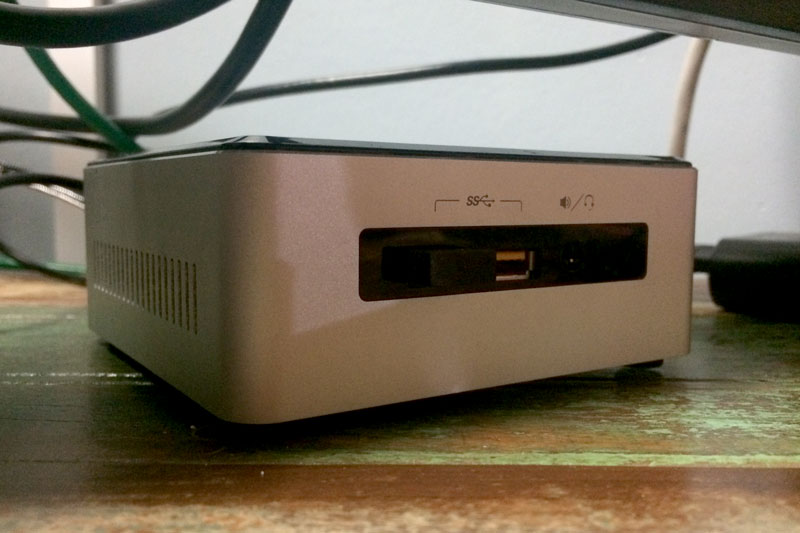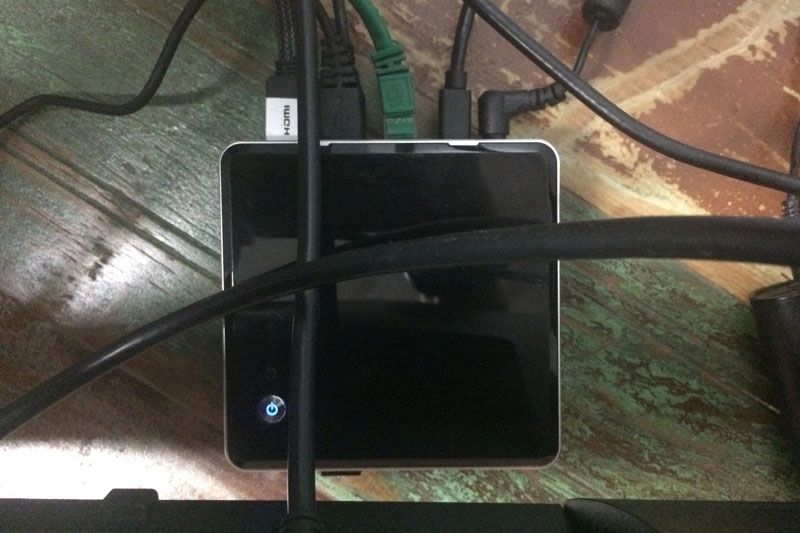The Intel NUC: One Year As A Workstation
I had a typical man-flu start to 2016. After coming back from Christmas break I was hit with an almighty cold or virus or something. It happens. When I recovered I was greeted by one of those things that reminds me why I love where I work; an Intel NUC had been deposited upon my desk. A fresh, shiny and tiny new computer to replace the crusty “shuttle” form-factor PC that had been slowly grinding to a halt toward the end of 2015 and playing havoc with my workflow.

The computer geek in me with flush with excitement, but a tiny skeptical voice in the back of my head was keen to point out “this thing is tiny, you can’t do any serious work on that! It’s a toy.” A year later, and the skeptic in me could not have been proved more wrong.
Within the NUC’s almost impossibly small confines hides a surprising amount of hardware. Granted it shouldn’t be surprising in the age of ultrabooks and increasingly thin laptops. But moving these lessons onto the desktop, where even modern “compact” computers are easily size of a games console, gives the illusion that there’s much more than meets the eye to the resulting miniaturisation.
The fact of the matter is that computers are powerful enough. They don’t need to be the lofty beige behemoths they once were. The floor-bound workstation of old has been relegated to gaming, CAD and data crunching- at least where it hasn’t been moved to “the cloud.” And I mean no disrespect to the classic “tower” PC. I’d love to try one someday to see what gaming in glorious ultra-high-definition across multiple displays feels like. But when it comes to choosing a system, I always have a soft spot for the compact; my first Apple computer was an early G4 Mac Mini and I adored it.
The wider landscape of computing has been rapidly changing and evolving over the last few years. Net-books and Net-tops made an eager appearance (I still have my Samsung NC10 and an awesome but nearly useless Sony VGN-P11Z) but dissolved into an almost invisible niche. Personal computer sales in general plateaued around 2012; no doubt struck a blow by the rapidly evolving tablet and smartphone markets and just as much so by the simple longevity of the modern computer. If you can keep a system from falling apart or wearing out then 5 years isn’t an unreasonable lifespan. What’s left is almost a niche market where the compact, utilitarian grunt of something like NUC should rightfully thrive.
Hardware
The Intel NUC is a form-factor, rather than a specific model of computer. The range spans a whole spectrum of computing needs featuring CPUs from i3 to i7, hard disks in SATA and M.2 flavour and anywhere from 2GB to 32GB of RAM. It runs the full gamut from “net-top” to workstation to compact gaming PC.

My NUC for the past year and a handful of days sports an Intel Core i7-557U, Intel Iris 6100 graphics and 16GB RAM. It also includes Intel Audio, Intel 7265 Wireless and, you guessed it, Intel l218-v Ethernet. It think it sits somewhere on the low end of high-end for a system so compact, and this shows.
You’ll notice from the specs that there’s a lot of “Intel” involved. Unsurprising, considering it’s their ecosystem, and undoubtedly the source of one of the NUCs greatest strengths; the lack of terrible drivers.
A system that consists almost entirely of components from a single vendor has the unusual benefit, at least in Windows 10, of the drivers potentially being refined and tested to work in perfect harmony. While I’ve no idea how much attention to detail Intel pay in this regard, I find it difficult to believe that they’re not carefully testing the drivers and components of their NUC range to ensure they behave nicely together.
My NUC has been phenomenally stable. In fact I can’t think of a single occasion when I’ve witnessed it BSOD. Firing up NirSoft BlueScreenView seems to confirm this: empty. The closest thing to a system crash I’ve seen is a brief screen blanking followed by a “Display Driver Stopped Responding and Has Recovered” message perhaps two or three times. A lot of this stability is owed to Windows 10 generally being “quite good” in that respect, the rest? The unexciting, but reliable hardware that comprises the NUC. Between Windows updates and reboots for software installs I’ve seen up-times of a month or more.
The NUC quite capably drives the two 27″ Dell 2560×1440 U2713HM displays that I spread my messy workload over; one connected to HDMI* and the other to DisplayPort. The Iris 6100 graphics are solid, more than enough for a code-monkey workstation, but for more serious CAD, or even Adobe Premiere are a little bit lacking. I’m keen to find more opportunity to edit video and while I’ve successfully done this on the NUC I’d prefer a little more horsepower to bring those encoding times down- I recently compared the integrated vs discrete graphics on a Razer Blade and found the latter some five times faster.
* these particular Dell monitors hate running at 2560×1440 over HDMI, so I have a custom profile for this
Aesthetic
When I was first setting up my NUC, an arduous task since I managed to find a conflict between Visual Studio and Atmel Studio 7 that prevented the former from installing, I actually unplugged it, tossed it in my bag, and carried it home to continue. Being able to do this is great, and with the lack of a screen and battery the NUC is actually easier- albeit far, far less useful on the move- to carry around. Yes normally you might use a laptop for exactly this reason, but sometimes it’s nice to have a workstation that you’re not obliged to carry everywhere with you. (Note: I work all the time anyway, so it makes little difference. D’oh!)
The NUC is utilitarian. I’m not going to say it’s ugly, since there’s nothing offensive about its design, but it makes absolutely no effort whatsoever to be attractive. It’s not an object that you’d be keen to put front and centre on your desk. That’s fine though, because having a computer that’s silent and invisible feels right in this day and age. The NUC is a quiet, unseen workhorse and doesn’t need to be attractive. I simply tuck it just behind and underneath one of my desk-mounted Dell monitors and rarely notice it.
It has two USB ports on the front, one of which is filled with a dongle I’ve forgotten the purpose of, and the other used to play home to my SteelSeries headphones before I realised there was a spare port around the back which I had previously used to keep my old SSD permanently connected. There are also two USB ports on the back.
I use a 9 port, powered USB hub with the NUC most of the time since I often connect and power multiple devices including AVR Dragon(s), Microchip PICKit, development boards, our own products and more. I’m a stickler for wired mice and keyboards, too, so my mouse and keyboard are also plugged into the hub. Granted, needing a multi-port hub does somewhat ruin part of the appeal of a compact PC. Still, when it comes to plugging in a USB device I find it much easier to move around a hub with two cables connected to it than a PC with five or six or so.

Also coming out of the back are the mini HDMI port, mini DisplayPort, ethernet and power making the rear of the NUC an almighty spaghetti mess. It doesn’t matter though, since it’s all hidden away.
Most of the time the NUC is quiet, but make no mistake; it’s fan cooled. During heavier workloads, or when I write and run some terrible code that should never see the light of day, the fan will spin up and can be rather loud. Most of the time it’s quiet as a mouse. Mice are quiet, right?
Workload
My typical workload varies quite heavily from day to day and depending on what I happen to be working on. Common tools in my armada are Visual Studio, Atmel Studio, Microchip MPLABX, Eagle 6, Adobe Photoshop/Illustrator/Premiere Pro, VirtualBox and an assortment of terminal emulators, code editors, browser, apps like Slack, and no-doubt a whole bunch of others I’ve forgotten about.
I switch between tasks quite frequently and have very, very little patience for hangups and delays. Fortunately the NUC has yet to fail me, and rightfully so I suppose since it’s if nothing a little overkill for a majority of what I do. But there’s the stickler with power and performance, it is much better to have it and not need it than to need it and not have it.
To manage the screen real-estate I use Windows 10’s built-in window snapping, giving me four 1280×1440 slices of display to fit tasks into. A good example may be Slack -> Code Editor -> Bash -> Browser Window but I have many permutations of workspace.
More involved tasks, such as designing PCBs in Eagle, see my left monitor become a full-screen schematic diagram, and my right a full-screen board view. Apps like Photoshop, Illustrator or Premier Pro will also occupy a full display.
Economy Of Scale
Miniaturisation isn’t going away. Making things smaller has many benefits, from economical to environmental to simply making attractive, compact products that fit into our modern expectations of what computers should be. I recently dug a Shuttle XPC out of our storage cupboard at Pimoroni to rebuild, and was simply blown away at how antiquated the form-factor felt. More so, the simple size of even a compact PC like the Shuttle and the parts inside it necessitate a tremendous amount of material to construct and a tremendous amount of packing to ship. I wonder how much longer the cutting-edge of computing can market GPU’s three times the size of a complete system.
If you’re looking for a solid, compact and quiet workhorse that you can drop behind your monitor and forget about, then then you should consider a NUC. They’re available in a dizzying range of options both as full kits and barebones systems and, since Ebuyer’s NUC landing page is perpetually broken, then a search for “Intel NUC” on their website isn’t a bad place to start.